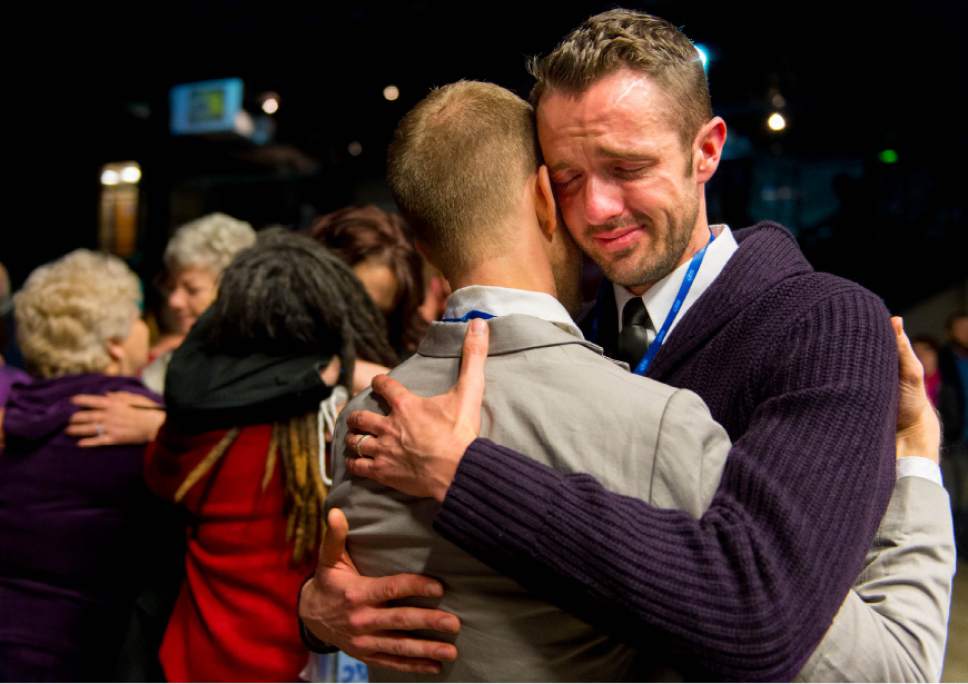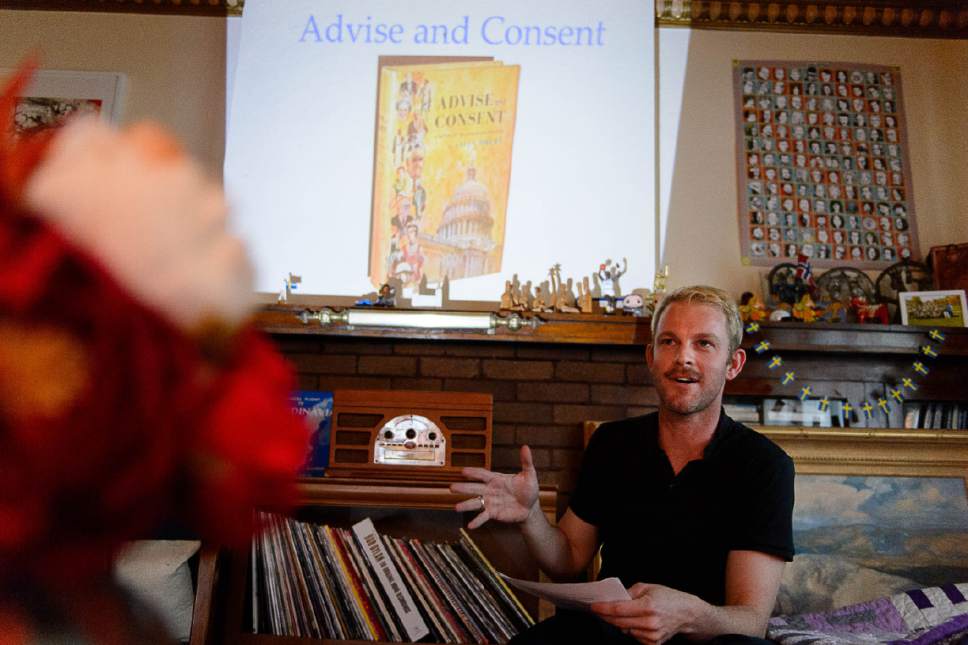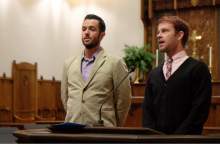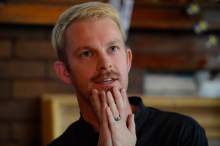This is an archived article that was published on sltrib.com in 2017, and information in the article may be outdated. It is provided only for personal research purposes and may not be reprinted.
The picture on the flier shows three smiling performers in bathing-suit-like strapless costumes adorned with a puff of tulle netting and elbow-length gloves. Long feathers protrude from the piles of their teased hair, and the text proclaims the act "Salt Lake City's most unusual show."
It might have been. The year was 1966, and the group known as The Missfits were men in drag performing at an old downtown establishment called the Tin Angel.
It's a rare slice of gay history and just one of the gems found in the new book "LGBT Salt Lake City" by J. Seth Anderson.
Published in May by South Carolina-based publisher Arcadia Books, the 95-page book offers a mostly pictorial walk though the secrets, struggles and triumphs of Utah's gay community, from the anti-gay territorial laws that put men in prison in the late 1800s to the city's first gay bars, early gay pride celebrations and the legalization of gay marriage.
"Salt Lake is a very queer place," Anderson said. "And I mean that in all the layers of the word: peculiar, odd or unusual. It's a place that defies binaries. It's both parochial and worldly. A big town and a small town. It's Mormon and non-Mormon."
Salt Lake's historical record also has two sides: the well-documented public history and the hidden stories held close by those who lived them, but whose place in the community was often at the fringes.
Anderson's goal in writing the book was to bring those hidden stories to light and show that LGBT individuals have long carved out their own vibrant space in Salt Lake City.
That's exactly what it's done for Joanna Smith, who attended an Anderson-led discussion of his work in a private home last week.
"I found it interesting and just beautiful that people were able to find each other, even underground, even when hiding in the closet … and were able to build a niche and an identity and a community," said Smith. "It's tragic, as well, that they had to do that."
The book has helped Smith wrap context and understanding around events and individuals that were already familiar to her.
"I'm finding that I knew a lot of this, but didn't know it affected me," she said, adding that the connect-the-dots quality of the work makes it a must-read for anyone interested in Mormon scholarship.
But the book isn't focused on gay Mormons or the relationship between the LGBT community and The Church of Jesus Christ of Latter-day Saints, the Utah-born Anderson said.
"I didn't want to make [that] the center of the book," he said. "Although you can't untangle a regional history of Utah without the Mormon church."
To research the book, Anderson combed the Utah State Archives and libraries at Brigham Young University, Utah State and the University of Utah, where he earned his master's degree in history.
He also turned to Utah's LGBT elders who were part of the gay liberation movement of the 1970s and helped open the doors for gays and lesbians to live their lives in the open.
All were generous, digging out boxes and albums of memorabilia to share, or pointing the author to others who might offer help.
Ben Williams was among those Anderson turned to.
An activist who in 1991 helped found the Utah Stonewall Center, a precursor to the current Utah Pride Center, Williams has been chronicling Utah's gay history for decades on the blog Utah Stonewall Society Archives.
"I think, really, Seth's book is groundbreaking," said Williams. "There isn't any other like it. It's a primer on gay Utah history."
The book's format offers readers a comprehensive glimpse at LGBT history that is easily accessible to all and will point the curious toward sources for deeper study and understanding.
And because gay history has more often been examined or chronicled in academic works, to have it available to all on the shelves of a local bookstore is "huge," Williams said.
Among the other historical treasures pictured in Anderson's book:
• Rare streetscape photos of Utah's first known gay bars, the Crystal Lounge and the Radio City Lounge, which opened in the late 1940s and early 1950s on Main Street.
• A protest outside the LDS Church's Temple Square in 1981 by Affirmation, a support group for gay church members. The protest marked the first time Salt Lake City granted a gay-rights group a permit to demonstrate on city streets.
• An emotional portrait of Clair Harward, an Ogden man who was excommunicated from the LDS Church after telling his bishop that he had AIDS. The 1985 pictures were published in The Salt Lake Tribune and shows Harward's body ravaged by Kaposi's sarcoma.
• Several pictures from the 1977 protest march and candlelight vigils held when former beauty queen Anita Bryant brought her Save Our Children campaign — to protect children from homosexuality — to Utah for a rally.
"I consider that Utah's Stonewall," Anderson said, referencing the 1969 riots outside a New York bar, the Stonewall Inn, that was a haven for gays. "This is the first time the [Utah] community gathered to protest in public … the first time the community thinks of itself as having rights and fighting back."
The book also includes of photo of Anderson and his husband, Michael Ferguson, who can claim their own spot in Utah's queer history. The couple were the first to marry on Dec. 20, 2013, after a federal judge struck down Utah's laws that banned gay unions. The ruling was the first in a series of judicial decisions that led to the legalization of gay marriage nationally.
Anderson said he hopes readers will find inspiration in the pictures and stories of courage and perseverance found in the book.
"It's my love letter to Salt Lake City," he said during the Wednesday night presentation. "That's how I thought of it." —
Sunday Pride Festival Events
Pride Parade
Route • Begins at 200 S. West Temple and ends at 400 East.
Start • 10 a.m.
Cost • Free
Festival events
Location • Washington Square and Library Plaza
Hours • 11 a.m. to 7 p.m.
Tickets • $10; kids younger 12 free; cash only













